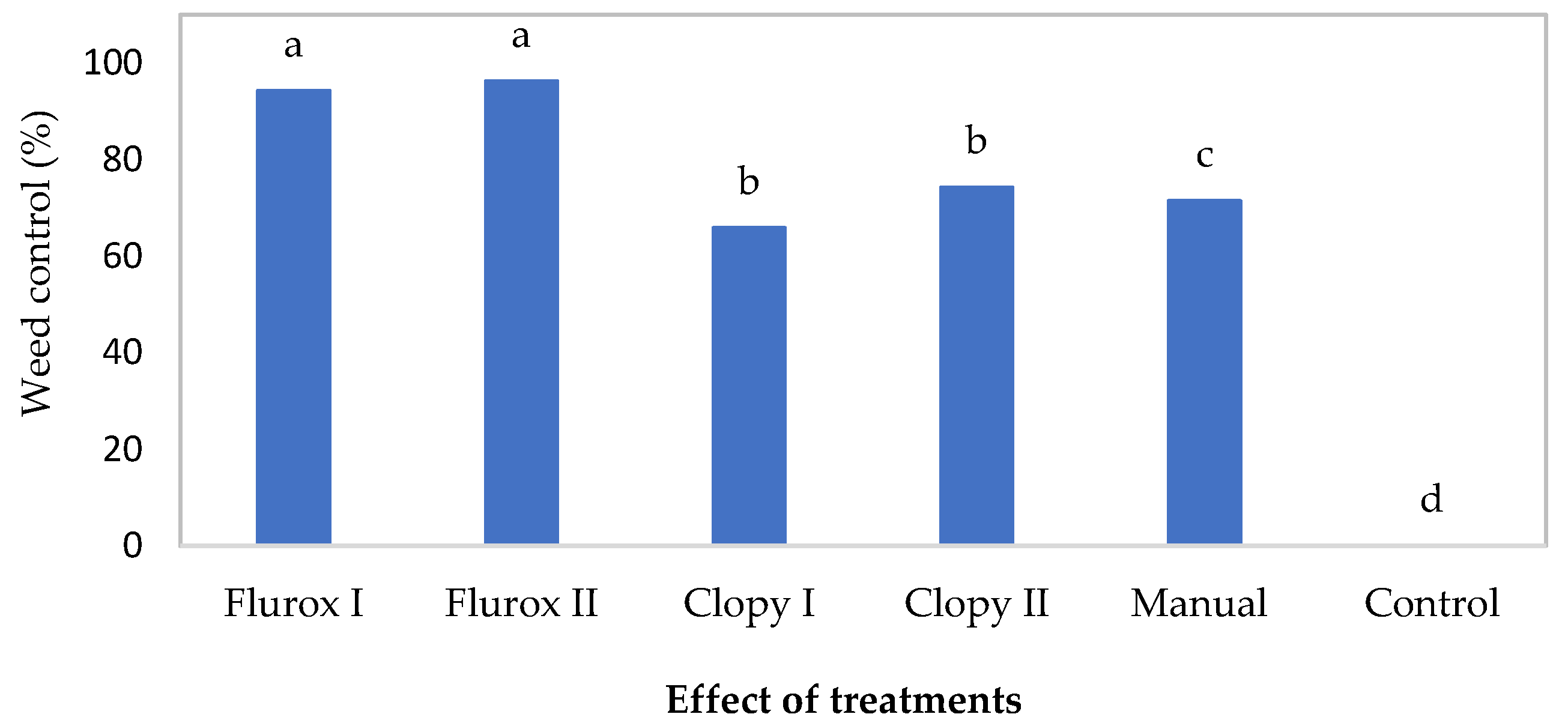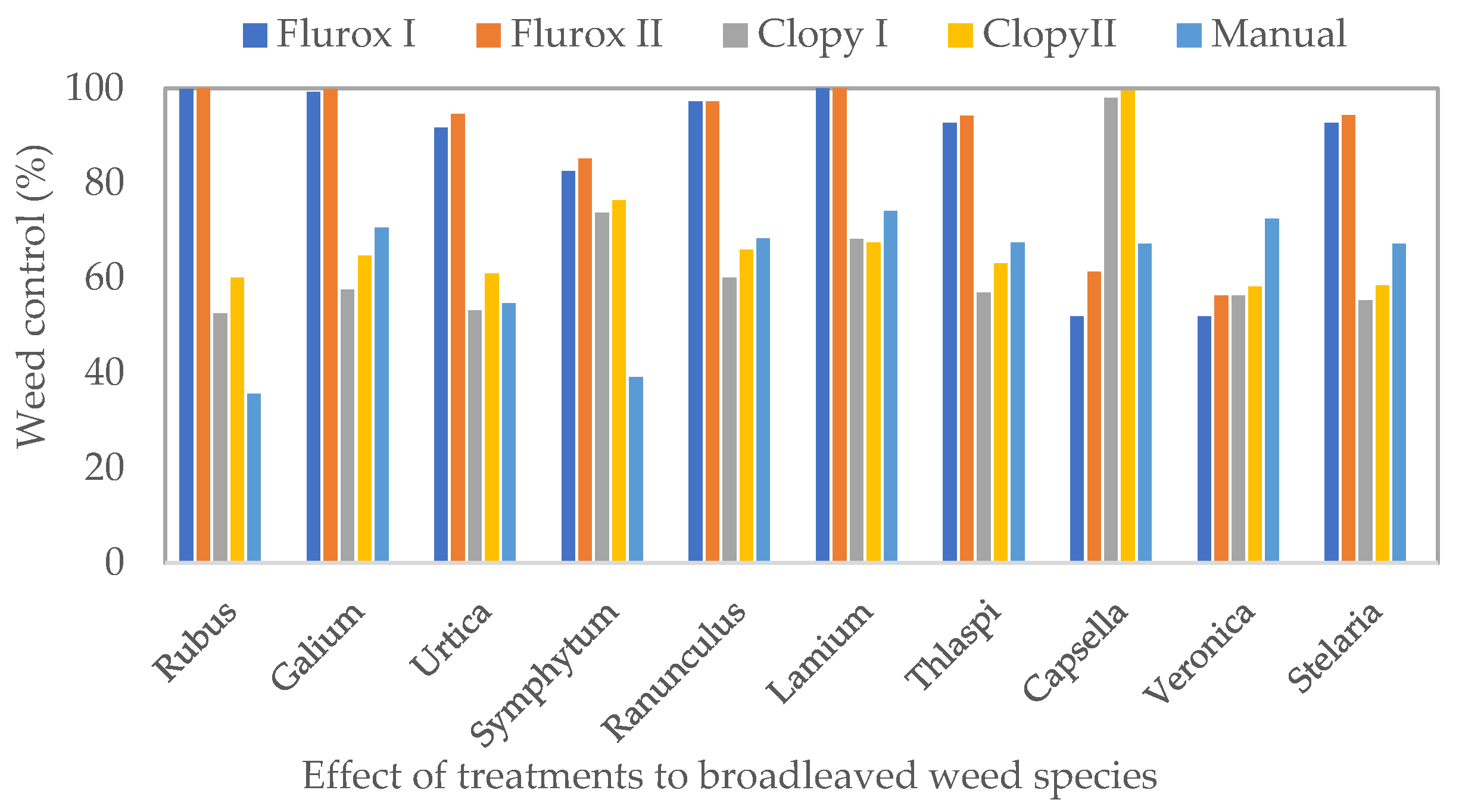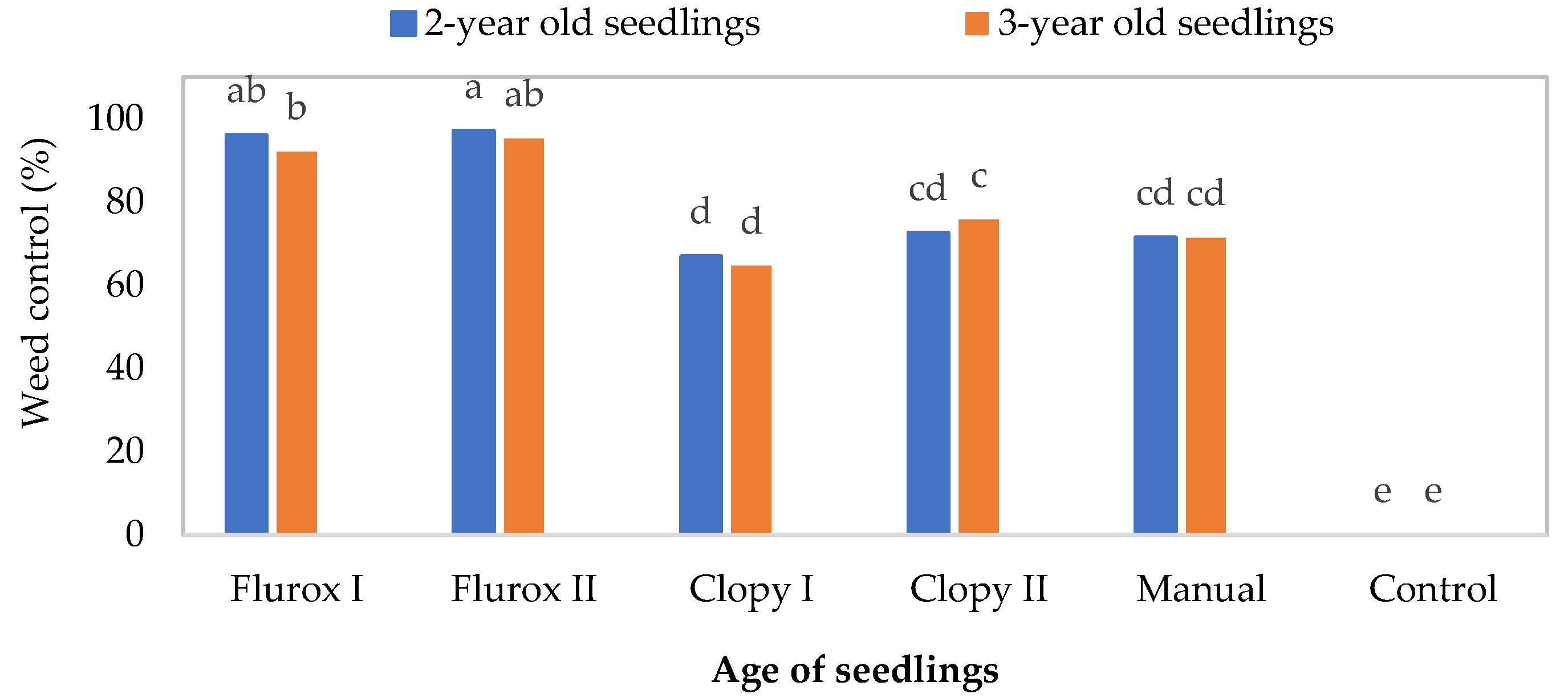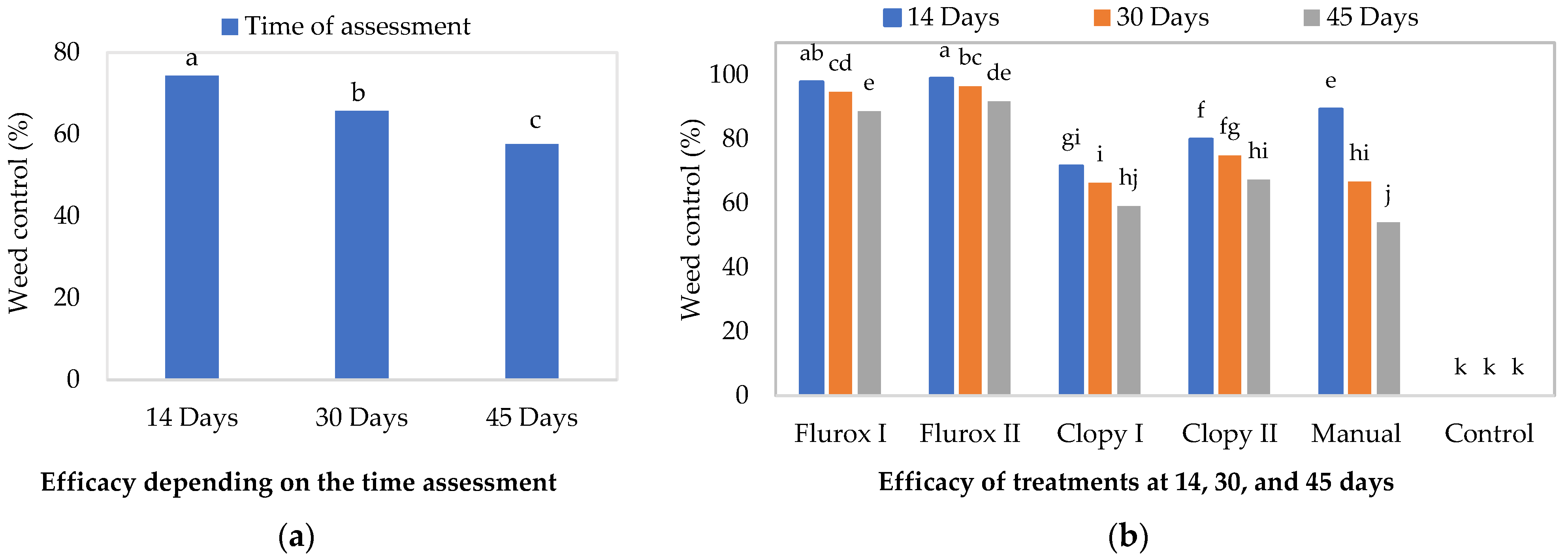Early Spring Broadleaved Weed Control during Seedling Dormancy in Regenerated Pedunculate Oak Forests
Abstract
1. Introduction
2. Materials and Methods
2.1. Study Sites and Experimental Design
2.2. Weed Control Treatments
2.3. Herbicide Efficiency and Measurements
2.4. Statistical Analysis
3. Results
3.1. Efficacy of Treatments for Early Spring Broadleaved Weed Control
3.2. Efficacy of Treatments for 2- and 3-Year-Old Seedlings
3.3. Efficacy of Treatments in Experiments during the Years of Investigation
3.4. Efficacy of Treatments during the Time of Assessment
3.5. Fresh Broadleaved Weed Biomass 45 Days after Treatments
3.6. Herbicide Phytotoxicity on 2- and 3-Year-Old Pedunculate Oak Seedlings in the Dormant Stage
4. Discussion
5. Conclusions
Author Contributions
Funding
Data Availability Statement
Conflicts of Interest
References
- Mauer, O.; Mauerova, P. Eliminating the Negative Influence of Forest Weeds in the Pedunculate Oak (Quercus robur L.) Regeneration on Alluvial Sites by Mowing to ‘High Stubble’. In Proceedings of the Forest Management Systems and Regeneration of Floodplain Forest Sites, Brno, Czech Republic, 8–9 October 2007; pp. 133–142. [Google Scholar]
- Vasic, V.; Hajnal-Jafari, T.; Djuric, S.; Kovacevic, B.; Stojnic, S.; Vasic, S.; Galovic, V.; Orlovic, S. Effect of Herbicide Clopyralid and Imazamox on Dehydrogenase Enzyme in Soil of Regenerated Pedunculate Oak Forests. Forests 2022, 13, 926. [Google Scholar] [CrossRef]
- Franklin, J.A.; Zipper, C.E.; Burger, J.A.; Skousen, J.G.; Jacobs, D.F. Influence of herbaceous ground cover on forest restoration of eastern US coal surface mines. New For. 2012, 43, 905–924. [Google Scholar] [CrossRef]
- Harmer, R.; Boswell, R.; Robertson, M. Survival and growth of tree seedlings in relation to changes in the ground flora during natural regeneration of an oak shelterwood. Forestry 2005, 78, 21–32. [Google Scholar] [CrossRef]
- Thompson, D.G.; Pitt, D.G. A review of Canadian forest vegetation management research and practice. Ann. For. Sci. 2003, 60, 559–572. [Google Scholar] [CrossRef]
- Wagner, R.G.; Newton, M.; Cole, E.C.; Miller, J.H.; Shiver, B.D. The role of herbicides for enhancing forest productivity and conserving land for biodiversity in North America. Wildl. Soc. Bull. 2004, 32, 1028–1041. [Google Scholar] [CrossRef]
- Rey Benayas, J.M.; Navarro, J.; Espigares, T.; Nicolau, J.M.; Zavala, M.A. Effects of artificial shading and weed mowing in reforestation of Mediterranean abandoned cropland with contrasting Quercus species. For. Ecol. Manag. 2005, 2012, 314–320. [Google Scholar] [CrossRef]
- Houskova, K.; Palatova, E.; Mauer, O. Possibilities and procedures for the natural regeneration of pedunculate oak (Quercus robur L.) in south moravia. In Proceedings of the Forest management systems and regeneration of floodplain forest sites, Brno, Czech Republic, 8–9 October 2007; pp. 89–98. [Google Scholar]
- Valkonen, S. Survival and growth of planted and seeded oak (Quercus robur L.) seedlings with and without shelters on field afforestation sites in Finland. For. Ecol. Manag. 2008, 225, 1085–1094. [Google Scholar] [CrossRef]
- Willoughby, I.; Jinks, R.L.; Kerr, G.; Gosling, P.G. Factors affecting the success of direct seeding for lowland afforestation in the UK. Forestry 2004, 77, 467–482. [Google Scholar] [CrossRef]
- Obiri, B.D.; Obeng, E.A.; Oduro, K.A.; Apetorgbor, M.M.; Peprah, T.; Duah-Gyamfi, A.; Mensah, J.K. Farmers’ perceptions of herbicide usage in forest landscape restoration programs in Ghana. Sci. Afr. 2021, 11, e00672. [Google Scholar] [CrossRef]
- Oliveira, L.; Marques, R.F.; Silva, A.C.; Marchi, S.R.; Martins, D. Selectivity of herbicides applied to Brazilian tree species at post-emergence. Arq. Inst. Biol. 2022, 89, 1–9. [Google Scholar] [CrossRef]
- Neal, J.C. Non-phenoxy herbicides for perennial broadleaf weed control in cool-season turf. Weed Technol. 1990, 4, 555–559. [Google Scholar] [CrossRef]
- Lupwayi, N.Z.; Harker, K.N.; Clayton, G.W.; Turkington, T.K.; Rice, W.A.; O’Donovan, J.T. Soil microbial biomass and diversity after herbicide application. Can. J. Plant Sci. 2004, 84, 677–685. [Google Scholar] [CrossRef]
- Kizildag, N.; Sagliker, H.; Cenkseven, S.; Cengiz Darici, H.; Kocak, B. Efects of imazamox on soil carbon and nitrogen mineralization under Mediterranean climate. Turk. J. Agric. For. 2014, 38, 334–339. [Google Scholar] [CrossRef]
- Filimon, M.N.; Roman, D.L.; Caraba, I.V.; Isvoran, A. Assessment of the Effect of Application of the Herbicide S-Metolachlor on the Activity of Some Enzymes Found in Soil. Agriculture 2021, 11, 469. [Google Scholar] [CrossRef]
- MacDonald, R.T.; Hall, J.C.; O’Toole, J.J.; Swanton, C.J. Field bindweed (Convolvulus arvensis) control with fluroxypyr. Weed Technol. 1993, 7, 966–971. [Google Scholar] [CrossRef]
- Lubbers, M.D.; Stahlman, P.W.; Al-Khatib, K. Fluroxypyr efficacy is affected by relative humidity and soil moisture. Weed Sci. 2007, 55, 260–263. [Google Scholar] [CrossRef]
- Gao, S.; Bie, C.; Liu, Y.; Zhang, T.; Fu, Y.; Ye, F. Functional Supramolecular of Inclusion Complex of Herbicide Fluroxypyr with HPβCD. Polymers 2018, 10, 1294. [Google Scholar] [CrossRef]
- Solomon, C.B.; Bradley, K.W. Influence of Application Timings and Sublethal Rates of Synthetic Auxin Herbicides on Soybean. Weed Technol. 2014, 28, 454–464. Available online: http://www.jstor.org/stable/43702225 (accessed on 28 August 2023). [CrossRef]
- EPPO PP 1/116(3); Guidelines for the Efficacy Evaluation of Plant Protection Products, Herbicides & Plant Growth Regulators. EPPO Standards: Paris, France, 1998.
- EPPO PP 1/135(4); PP1 2nd Edition, Efficacy Evaluation of Plant Protection Products. EPPO Standards: Paris, France, 2004.
- Dixon, F.L.; Clay, D.V. Effect of herbicides applied pre- and post-emergence on forestry weeds grown from seed. Crop Protect. 2004, 23, 713–721. [Google Scholar] [CrossRef]
- Zhang, F.; Bai, S.; Wang, H.; Liu, W.; Wang, J. Greenhouse and field evaluation of a novel HPPD-inhibiting herbicide, QYM201, for weed control in wheat. Sci. Rep. 2019, 9, 1625. [Google Scholar] [CrossRef]
- Mesedzija, M.; Markovic, N.; Bursic, V.; Sobic, J. Weed control in turfgrass production, Zbornik radova. In Contemporary Agriculture; XIX Savetovanje o Biotehnologiji; University of Novi Sad: Novi Sad, Serbia, 2014; Volume 19, pp. 479–483. [Google Scholar]
- Tran, H.; Harrington, K.C.; Robertson, A.W.; Watt, M.S. Relative persistence of commonly used forestry herbicides for preventing the establishment of broom (Cytisus scoparius) seedlings in New Zealand plantations. N. Z. J. For. Sci. 2015, 45, 1–3. [Google Scholar] [CrossRef][Green Version]
- Willoughby, I.; Jinks, L.R.; Stokes, V. The tolerance of newly emerged broadleaved tree seedlings to the herbicides clopyralid, cycloxydim and metazachlor. Forestry 2006, 79, 599–608. [Google Scholar] [CrossRef]
- Jinks, R.L.; Willoughby, I.; Baker, C. Direct seeding of ash (Fraxinus excelsior L.) and sycamore (Acer pseudoplatanus L.): The effects of sowing date, pre-emergent herbicides, cultivation, and protection on seedling emergence and survival. For. Ecol. Manag. 2006, 237, 373–386. [Google Scholar] [CrossRef]
- Clay, D.V.; Dixon, F.L.; Willoughby, I. Efficacy of graminicides on grass weed species of forestry. Crop Prot. 2006, 25, 1039–1050. [Google Scholar] [CrossRef]
- Radjevic, V.; Pap, P.; Vasic. V. Management of the common oak forests in Ravni Srem: Yesterday, today, tomorrow. Topola/Poplar 2020, 206, 41–52. [Google Scholar]
- Willoughby, I.H.; Harmer, R.; Morgan, G.W.; Peace, A.J. Triclopyr applied in the winter dormant season can give effective control of bramble (Rubus fruticosus L. agg.) without damaging young tree seedlings or other non-target vegetation. Forestry 2013, 86, 59–69. [Google Scholar] [CrossRef]
- EPPO. Available online: https://www.eppo.int/ACTIVITIES/plant_protection_products/registered_products (accessed on 10 October 2023).
- Lowery, R.F.; Lambeth, C.C.; Endo, M.; Kane, M. Vegetation management in tropical forest plantations. Can. J. For. Res. 1993, 23, 2006–2014. [Google Scholar] [CrossRef]
- Nelson, D.; Thoreson, M. Competition between Potatoes (Solanum tuberosum) and Weeds. Weed Sci. 1981, 29, 672–677. [Google Scholar] [CrossRef]
- Gegner-Kazmierczak, S.; Hatterman-Valenti, H. Strip Tillage and Early-Season Broadleaf Weed Control in Seeded Onion (Allium cepa). Agriculture 2016, 6, 11. [Google Scholar] [CrossRef]
- Modry, M.; Hubeny, D.; Rejsek, K. Differential response of naturally regenerated European shade tolerant tree species to soil type and light availability. For. Ecol. Manag. 2004, 188, 185–195. [Google Scholar] [CrossRef]
- Balandier, P.; Collet, C.; Miller, J.H.; Reynolds, P.E.; Zedaker, S.M. Designing Forest vegetation management strategies based on the mechanisms and dynamics of crop tree competition by neighbouring vegetation. Forestry 2006, 79, 3–27. [Google Scholar] [CrossRef]
- Dobrowolska, D. Effect of stand density on oak regeneration in flood plain forests in Lower Silesia Poland. Forestry 2008, 81, 511–523. [Google Scholar] [CrossRef]
- Harmer, R.; Kiewitt, A.; Morgan, G. Can overstorey retention be used to control bramble (Rubus fruticosus L. agg.) during regeneration of forests? Forestry 2012, 85, 135–144. [Google Scholar] [CrossRef]
- Burger, J.A.; Zipper, C.E.; Angel, P.N.; Evans, D.M.; Eggerud, S. Reforestation Guidelines for Unused Surface Mined Lands: Development, Application, and Adoption, Proceedings of the National Meeting of the American Society of Mining and Reclamation. Reclamation: Sciences leading to Success, Bismarck, ND, USA, 11–16 June 2011; Barnhisel, R.I., Ed.; Lexington: Bismarck, ND, USA, 2011; pp. 90–112. [Google Scholar]
- Duque, T.S.; Oliveira, F.S.; Souza, I.M.; Fernandes, B.C.C.; da Silva Rodrigues, L.L.L.; Silva, D.V.; dos Santos, J.B. Efficacy of S-metolachlor + glyphosate for Weed Control in Different Levels of Eucalyptus Straw. Forests 2023, 14, 1828. [Google Scholar] [CrossRef]
- Yu, P.; Marble, S.C. Practice in Nursery Weed Control-Review and Meta-Analysis. Front. Plant Sci. 2022, 12, 807736. [Google Scholar] [CrossRef] [PubMed]
- Zand, E.; Baghestani, M.A.; AghaAlikhani, M.; Soufizadeh, S.; Khayami, M.M.; PourAzar, R.; Sabeti, P.; Jamali, M.; Bagherani, N.; Forouzesh, S. Chemical control of weeds in wheat (Triticum aestivum L.) in Iran. Crop Prot. 2010, 29, 1223–1231. [Google Scholar] [CrossRef]
- FSC. FSC List of Lists of Highly Hazardous Pesticides. Bonn, Germany: Forestry Stewardship Council. 2019. Available online: https://connect.fsc.org/forest-management-certification/pesticides-policy (accessed on 5 October 2023).
- EPA. Available online: https://www.epa.gov/ingredients-used-pesticide-products/registration-review-pyridine-and-pyrimidine-herbicides (accessed on 12 October 2023).






Disclaimer/Publisher’s Note: The statements, opinions and data contained in all publications are solely those of the individual author(s) and contributor(s) and not of MDPI and/or the editor(s). MDPI and/or the editor(s) disclaim responsibility for any injury to people or property resulting from any ideas, methods, instructions or products referred to in the content. |
© 2023 by the authors. Licensee MDPI, Basel, Switzerland. This article is an open access article distributed under the terms and conditions of the Creative Commons Attribution (CC BY) license (https://creativecommons.org/licenses/by/4.0/).
Share and Cite
Vasic, V.; Djilas, M.; Kovacevic, B.; Vasic, S.; Poljaković-Pajnik, L.; Pap, P.; Orlovic, S. Early Spring Broadleaved Weed Control during Seedling Dormancy in Regenerated Pedunculate Oak Forests. Forests 2023, 14, 2286. https://doi.org/10.3390/f14122286
Vasic V, Djilas M, Kovacevic B, Vasic S, Poljaković-Pajnik L, Pap P, Orlovic S. Early Spring Broadleaved Weed Control during Seedling Dormancy in Regenerated Pedunculate Oak Forests. Forests. 2023; 14(12):2286. https://doi.org/10.3390/f14122286
Chicago/Turabian StyleVasic, Verica, Milutin Djilas, Branislav Kovacevic, Sreten Vasic, Leopold Poljaković-Pajnik, Predrag Pap, and Sasa Orlovic. 2023. "Early Spring Broadleaved Weed Control during Seedling Dormancy in Regenerated Pedunculate Oak Forests" Forests 14, no. 12: 2286. https://doi.org/10.3390/f14122286
APA StyleVasic, V., Djilas, M., Kovacevic, B., Vasic, S., Poljaković-Pajnik, L., Pap, P., & Orlovic, S. (2023). Early Spring Broadleaved Weed Control during Seedling Dormancy in Regenerated Pedunculate Oak Forests. Forests, 14(12), 2286. https://doi.org/10.3390/f14122286





